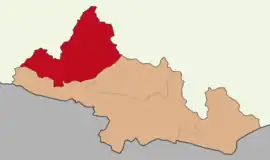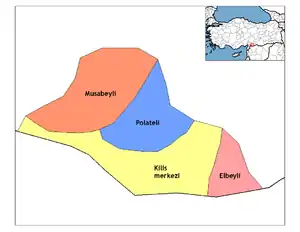Musabeyli District | |
|---|---|
 Map showing Musabeyli District in Kilis Province | |
 Musabeyli District Location in Turkey | |
| Coordinates: 36°53′11″N 36°55′6″E / 36.88639°N 36.91833°E | |
| Country | Turkey |
| Province | Kilis |
| Seat | Musabeyli |
| Area | 346 km2 (134 sq mi) |
| Population (2022) | 12,390 |
| • Density | 36/km2 (93/sq mi) |
| Time zone | TRT (UTC+3) |
| Website | www |
Musabeyli District is a district of Kilis Province of Turkey. Its seat is the town Musabeyli.[1] The district is mostly populated by Turks but also Kurds, Romani people and Arabs.[2] It had a total population of 12,390 in 2022.[3] Its area is 346 km2.[4]
Composition
There is one municipality in Musabeyli District:[1]
There are 46 villages in Musabeyli District:[5]
- Ağcakent
- Aşağıbademli
- Aşağıkalecik
- Balıklı
- Belentepe
- Bozkaya
- Çayıraltı
- Çınarköy
- Dorucak
- Dutluca
- Fericek
- Fırlaklı
- Geçitboyu
- Gökmusa
- Gözlüce
- Gündeğer
- Hacılar
- Hasancalı
- Haydarlar
- Hüseyinoğlu
- Karadut
- Karbeyaz
- Kayapınar
- Kaynaklı
- Kızılkent
- Koçcağız
- Kolpınar
- Körahmethüyüğü
- Kozlubağ
- Kurtaran
- Kürtüncü
- Madenyolu
- Sabanlı
- Şenlikçe
- Tahtalıkaradut
- Tokaçgemriği
- Topallar
- Üçpınar
- Uğurtepe
- Yastıca
- Yedigöz
- Yeşiloba
- Yukarıbademli
- Yukarıkalecik
- Yuvabaşı
- Zeytinbağı
History
Out of the 74 settlements he listed in the Ottoman nahiyah of Musabekli, 19th-century traveler Martin Hartmann noted 41 as Turkish (with a total of 554 households), 25 as Kurdish (247 households), 1 as Turkish and Abdal mixed (10 households), and 7 without any information on the population.[6]
References
- 1 2 İlçe Belediyesi, Turkey Civil Administration Departments Inventory. Retrieved 22 December 2022.
- ↑ Erberdi, Ebru. "Farklı kültürden insanların yaşadığı ilçe: Musabeyli". Sözcü. Retrieved 21 November 2022.
- ↑ "Address Based Population Registration System (ABPRS) - Results of 31 December 2022" (XLS). TÜİK. Retrieved 12 March 2023.
- ↑ "İl ve İlçe Yüz ölçümleri". General Directorate of Mapping. Retrieved 1 March 2023.
- ↑ Köy, Turkey Civil Administration Departments Inventory. Retrieved 1 March 2023.
- ↑ Hartmann, Martin (1894). Das liwa Haleb (Aleppo) und ein Teil des Liwa Dschebel Bereket. Berlin: W. Pormetter. pp. 100–101. Retrieved 30 November 2022.
This article is issued from Wikipedia. The text is licensed under Creative Commons - Attribution - Sharealike. Additional terms may apply for the media files.
